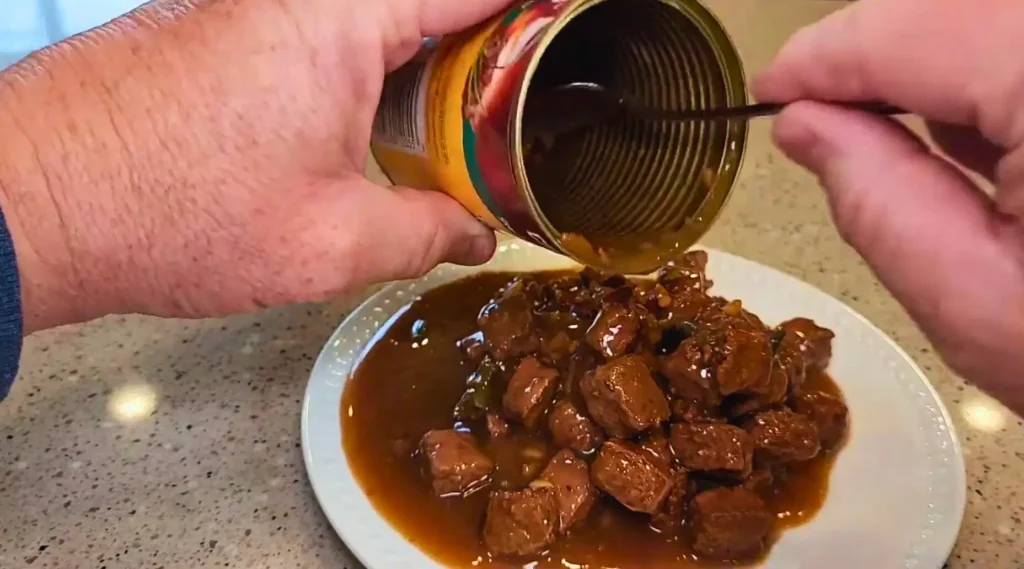
Choosing the right food for your dog can be a tiring and demanding process. I can tell that you too are wondering about the wet dog food brands. Are you looking to avoid the worst ones? Well, if yes is the case, then this post is a special gift for you. For the convenience of your dog, I have tried to cover some bad wet food brands in the UK that you must avoid.
The interesting thing about most of these brands is that they do follow some standard measures but when it comes to picking the right ingredients for your dog’s food, they choose the problematic ingredients. When it comes to the usage of these brands, they might look fine to some users but many of them are known to be silent killers for your dog. They create problems for your dog’s digestive system and have an overall negative impact on the health.
What is wet dog food?
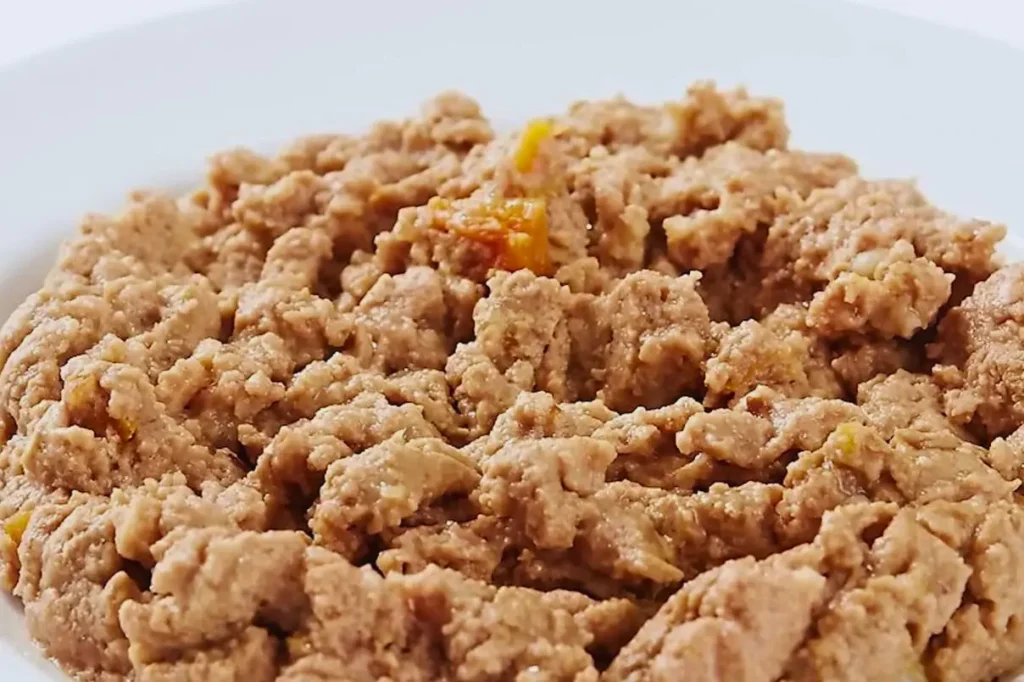
Wet dog food, which can also be called canned dog food is a soft and moist type of food that comes in cans or pouches. Compared to dry dog food, this food contains higher levels of moisture and is often made from a mixture of meat, vegetables, and grains. These foods can often be more expensive compared to dry dog foods.
How do you know if the wet dog food is good?
To find that you should just check the ingredients on the back of the label. The first ingredient should be a specific meat like “fresh beef,” “chicken,” or “salmon.” Avoid anything “made with the sub-products of animals” because it’s leftovers and it is not real meat. Also, do keep an eye out for fillers like corn, wheat, maize, soy, rice, etc. Make sure the first ingredient isn’t water or soup. That way, you can pick better food for your lovely pup!
The ingredients to avoid in wet dog foods
There are a lot of ingredients that are not good for your dog’s health. I also review the brands by looking at these ingredients. They are mentioned below.
- Artificial Additives: You should say no to wet dog foods that come with fake preservatives, colors, and flavors. This is because they might cause allergies.
- Excessive Fillers: You should skip products that come with too much corn, wheat, soy, or other fillers. Your dog needs more nutritious stuff.
- By-Products: Do look out for vague meat by-products. Go for the foods that come with clear, quality meat sources.
- Added Sugars: Always check for extra sugars or sweeteners as too much sugar can make your dog chubby.
- High Sodium Content: You should also be cautious about high salt levels as too much salt isn’t good for your pup’s health.
- Artificial Thickeners: Avoid wet dog foods that come with artificial thickeners like carrageenan. They might upset your dog’s stomach.
- Unspecified Protein Sources: Pick foods that clearly say where the protein comes from. “Meat” or “animal protein” is too vague so avoid that.
- Unbalanced Nutrients: Make sure the food is nutritionally balanced. Check for the labels of approval from the UK authorities.
wet dog foods advantages compared to the dry dog foods
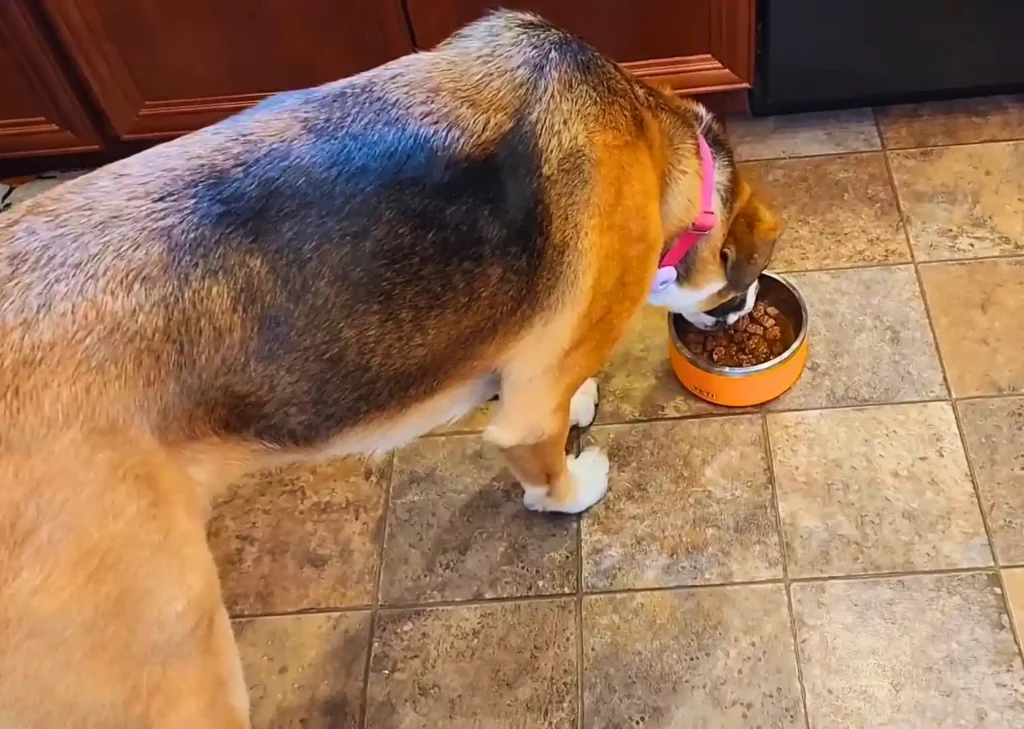
Wet dog food does come with some advantages because of its freshness. However, if it gets compared to the dry dog food, it will win as you can see major differences. Some of its advantages are mentioned below.
- For overweight dogs, the extra water in wet food can help them in feeling full and aiding them in weight loss.
- If your dog is a picky eater, they might prefer the taste and texture of canned wet food over dry kibble. The wet dog foods indeed seem better than the traditional dry foods.
- The wet dog food is very much great for older dogs. Especially those that have their teeth gone missing because wet food doesn’t require much chewing.
- Some wet food looks more natural and resembles a homemade stew which makes it appealing to dogs. Again, the picky eaters can opt for them.
- One major advantage is that the wet dog food is opened daily which ensures freshness while kibble bags can be open for weeks and are at risk of staleness or bacterial growth.
- Unlike kibble where fats and oils can go bad with time, the wet food remains fresher and is less prone to spoilage.
- If you have to feed any medication to your dog, it’s easy to mix it or the vitamin pills into wet food. This simplifies the process of giving your dog the necessary supplements.
Are there any downsides to wet dog food?
Yes, just like many other kinds of foods, there are some cons related to wet dog foods. Wet foods cost more than dry foods because they have a lot of water. Canned food has up to 80% moisture, while dry kibble only has around 10%. So, this creates a major difference. When it comes to feeding, your dog should eat wet food right away. If they don’t like it, you can’t save it for tomorrow like you can with kibble. Another advantage of dry food is that it is better for your dog’s teeth and can help clean them when they chew whereas wet food sticks to teeth, so you need to clean them.
The criteria of the worst reviews of wet dog foods
To create the criteria for judging the worst dog foods, the sole tool was the ingredients. These ingredients were mentioned by vets and also by some of my friends who have experience in choosing wet dog foods. The things that mattered the most were that if the main ingredient is specific meat, the label mentions the food as ‘complete’, and there should not be too many Artificial flavors, colors, etc. These were the major things that were kept in mind while devising the judgment criteria. Surprisingly, in the UK many brands do seem okay but if you get a closer look at what they are feeding your pets, you will be shocked a lot! So, the whole purpose of this post is to make you aware of the judgment criteria for wet food brands and the worst wet food brands that can help you in choosing the right one.
The worst wet dog food brands UK
Below is a list of the worst wet dog food brands that are not suitable for the overall health of your dog. You can even find many of them on different review sites as well where several users have raised a lot of complaints against them. Here are the reviews.
Gravy Train Wet Dog Food:
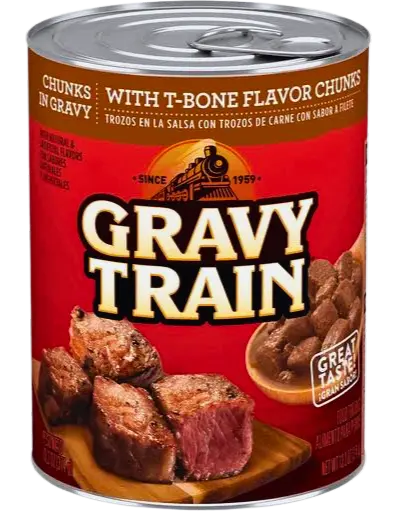
Bad reputation:
I’ll be starting with this one as once it was a reputable brand. Gravy Train’s current standing labels it as one of the worst dog food products, as time changes. While it pioneered the use of gravy, a blend of dry kibble with water for added flavor, this alone shouldn’t be the deciding factor for your purchase. When there is a lot of negative user feedback, it raises serious concerns.
Major Con:
Gravy Train’s primary components include maize, soy, wheat middlings, beef, and bone meal qualities are associated with the least desirable dog food brands. Considering the feedback and ingredient profile, I will recommend you to go for exploring alternative dog food options for your pet’s well-being, which is needed the most.
Ingredients:
Water sufficient for processing, chicken, poultry-by-product, soybean meal, ground corn, calcium carbonate, onion extract, choline chloride, garlic extract, vitamins (vitamin E supplement, thiamine mononitrate, niacin, vitamin A supplement, d-calcium pantothenate, riboflavin supplement, pyridoxine hydrochloride, vitamin B12 supplement, vitamin D3 supplement, folic acid, biotin), minerals (ferrous sulfate, zinc oxide, manganous oxide, copper sulfate, calcium iodate, sodium selenite).
Purina Beneful Wet Food (Tubs):
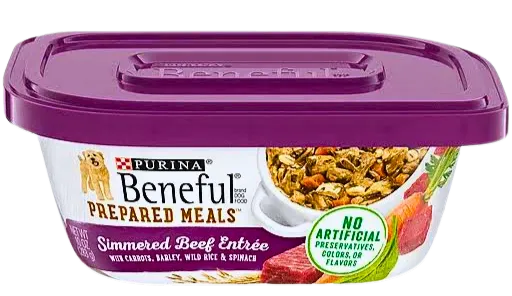
Major issue:
This is the next wet dog food brand for you and the primary ingredient here is chicken broth, which, while providing modest nutritional value, is commonly used in canned products for flavor and moisture. Moving on to another ingredient which is wheat gluten. It is a rubbery residue that is left after removing starchy carbohydrates from wheat.
Faulty factors:
While wheat gluten contains 80% protein, its biological value is expected to be lower than meat. Cheaper plant-based ingredients like this can inflate the total protein reported on the label, influencing perceptions of the actual meat content in the dog food. It’s essential to consider these factors when evaluating the nutritional value of the product.
Ingredients:
Chicken broth, chicken, wheat gluten, liver, meat by-products, carrots, peas, rice, barley, corn starch-modified, soy flour, minerals [potassium chloride, zinc sulfate, ferrous sulfate, copper sulfate, manganese sulfate, potassium iodide], sodium selenite, tricalcium phosphate, vitamins [vitamin E supplement, niacin (vitamin B-3), thiamine mononitrate (vitamin B 1), calcium pantothenate (vitamin B5), pyridoxine hydrochloride (vitamin B-6), vitamin B-12 supplement, riboflavin supplement (vitamin B-2), vitamin A supplement, folic acid (vitamin B-9), vitamin D-3 supplement, biotin (vitamin B-7), ], choline chloride.
Pedigree Choice Cuts (Canned):
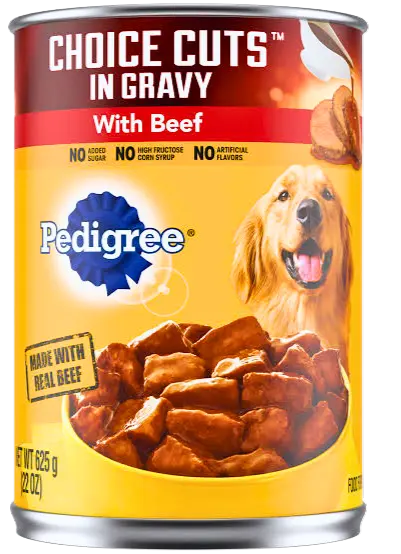
Lack of clarity:
This wet dog food has the first ingredient as water, contributing solely to moisture, a common presence in canned dog foods. It is followed by chicken which is defined as the clean combination of flesh and skin derived from chicken carcasses. The third ingredient, meat by-products, comprises slaughterhouse waste, including parts not used in prime muscle cuts. Next is wheat flour, and contrary to some beliefs, wheat isn’t inherently bad. However, the type of wheat used in pet foods may mirror the one that is used in livestock feed. The ambiguity leaves room for variability. When you can be clear like the other mentioned ingredients, you should be clear about the rest too. Understanding these ingredients is very helpful in assessing the nutritional profile and quality of the dog food in question.
Ingredients:
Sufficient water for processing, chicken, meat by-products, wheat flour, beef, liver, wheat gluten, peas, salt, carrots, sodium tripolyphosphate, natural flavors, guar gum, vegetable oil (source of linoleic acid), caramel coloring, minerals (potassium chloride, zinc sulfate, copper sulfate, potassium iodide), sodium alginate, bay leaves, xanthan gum, onion powder, vitamins (vitamin E, A & D3 supplements, d-calcium pantothenate, thiamine mononitrate {vitamin B1}, biotin), garlic powder, yellow #6, yellow #5
Chewdles Adult Semi-Moist Complete Chicken And Vegetables Dog Food:
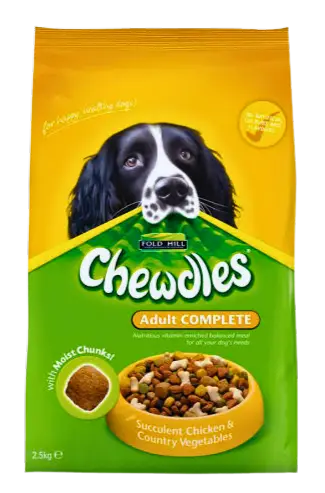
Full of cons:
Chewdles Adult Semi-Moist Complete Chicken And Vegetables Dog Food claims the throne as one of the worst dog foods in the UK. This cereal-based food is composed of 55% cereals, with 25% being maize meal, essentially coarsely ground corn flour. The inclusion of little, questionably sourced meat in the form of meat meal adds to the concerns, possibly sourced from rendering plant leftovers. Here again, you can find the lack of clarity.
No clarity:
The origin of oils and fats remains unknown throughout the long list and whole vegetables are notably absent from Chewdles. The ingredient list even includes “various sugars,” adding to the uncertainty. Choosing Chewdles means uncertainty about what you’re feeding your pooch, and while it might be tempting to them, it’s not a healthy choice. It is highly recommended to steer clear of this brand altogether. The health of your dog must never be risked!
Ingredients:
Cereals (30% brown rice and 25% maize meal in yellow kibble), Meat and Animal Derivatives (20% chicken meal in the chunks, 26% meat meal in red/brown kibble), Oils and Fats, Vegetable Protein Extract, Various Sugars, Minerals (including 0.5% calcium), Yeasts, Vegetables (4% pea flour in green kibble), Derivatives of Vegetable Origin, Milk and Milk Derivatives, Sensory Additives: Colourants; Technological Additives: Preservatives; Nutritional Additives (kg): Vitamin A 11300IU, Vitamin D3 770IU, Vitamin E 57mg, Iron (Ferrous Sulphate Monohydrate) 74mg, Zinc (Zinc Sulphate Monohydrate) 38mg, Manganese (Manganous Sulphate Monohydrate) 22.5mg, Copper (Cupric Sulphate Pentahydrate) 12.2mg, Iodine (Calcium Iodate Anhydrous) 1.3361mg, Manganese (Manganous Oxide) 0.3mg, Selenium (Sodium Selenite) 0.14mg.
Ol’ Roy Dog Food (Canned):
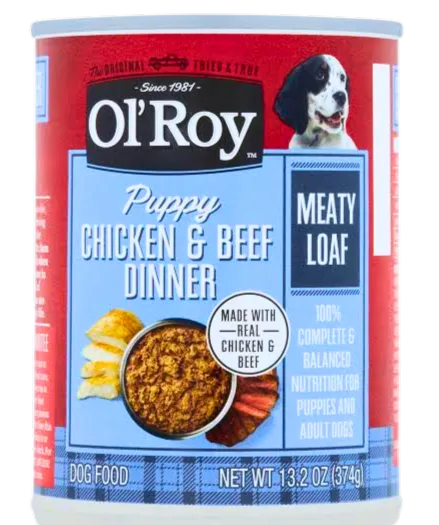
Vagueness:
Ol’ Roy is another brand that is known to be a grain-inclusive canned dog food that relies heavily on both named and unnamed meat by-products as its primary sources of animal protein. Unfortunately, the lack of specificity in the meat source makes it challenging to identify potential food allergies, while purchasing for sensitive dogs.
Confusion:
The inclusion of wheat flour as an ingredient, while being a cost-effective cereal grain, offers only modest nutritional value for dogs and is considered controversial. The liver, normally a quality component, loses its appeal due to the undisclosed source. Artificial coloring, including titanium dioxide and iron oxide, also raises concerns because they are not generally recommended.
Risks:
Titanium dioxide, classified as a potential carcinogen, may pose risks to the health of your dog. Iron oxide, a synthetic color additive used in various industries, carries some associations with rust. These factors, coupled with the unknowns in the meat sources, make Ol’ Roy a questionable choice for your dog’s health. So, I will recommend you consider alternatives that have clearer ingredient transparency for a more nutritious option.
Ingredients:
Water, chicken, meat by-products, wheat flour, beef, liver, modified corn starch, chicken meal, salt, vegetable oil (preserved with BHA/BHT), sodium tripolyphosphate, potassium chloride, calcium carbonate, artificial filet mignon flavor, titanium dioxide (color), iron oxide (color), vitamins (vitamin E supplement, vitamin A supplement, thiamine mononitrate, niacin supplement, d-calcium pantothenate, riboflavin supplement, pyridoxine hydrochloride, vitamin D3 supplement, folic acid, biotin, vitamin B12 supplement), caramel color, minerals (ferrous sulfate, zinc oxide, manganous oxide, copper sulfate, calcium iodate, sodium selenite), choline chloride, onion extract, garlic extract
Iams ProActive Health Dog Food (Canned):

No clarity:
If I am to judge this food solely on its ingredients, Iams ProActive Health canned dog food appears to be a below-average wet product. It includes a notable amount of both named and unnamed meats and meat by-products as the primary source of animal protein. Chicken, being rich in essential amino acids, is beneficial for a dog’s overall health. However, a crucial detail lies in the use of the word “with” in the product’s name such as “with chicken.” This indicates that chicken content likely totals around a minimum percent of the total weight, influencing the overall quality of the food.
Risks:
Additionally, I will say that carrageenan is a thickening agent that is extracted from seaweed and it raises concerns due to recent controversies surrounding its long-term biological safety. While it has a long history as a food additive, staying informed about potential health considerations is very important. Consider exploring alternative dog foods that have a clearer ingredient transparency for a more confident choice.
Ingredients:
Chicken, sufficient water for processing, meat by-products, brown rice, barley, feeding oatmeal, flax seed, sodium tripolyphosphate, minerals (potassium chloride, magnesium proteinate, zinc sulfate, copper proteinate, manganese sulfate, copper sulfate, potassium iodide), dried yam, carrageenan, xanthan gum, natural flavors, vitamins (choline chloride, vitamin E supplement, thiamine mononitrate {vitamin B1}, d-calcium pantothenate, biotin, vitamin A supplement, vitamin D3 supplement), dl-methionine, glycine, fish oil, yellow 6, yellow 5, sage, pyridoxine hydrochloride (vitamin B6).
Cesar Classics Dog Food (Wet):
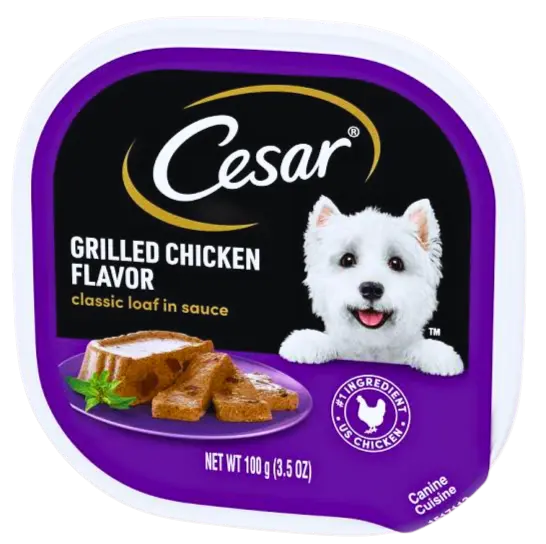
Lacking areas:
Based on its ingredients, Cesar Classics Dog Food also seems to be an average wet dog food product. The inclusion of chicken broth, while offering modest nutritional value, is a common addition in many canned dog foods for enhanced flavor and moisture. However, some considerations impact the overall quality. Notably, the minerals listed, except for magnesium, do not appear to be chelated. What are these? Chelated minerals are generally associated with high quality dog foods as they are easier for dogs to absorb in their stomachs.
Risks:
The inclusion of sodium nitrite, a controversial color preservative, raises concerns. Sodium nitrite has been associated with the production of cancer-causing substances (nitrosamines) especially when it is exposed to high cooking temperatures. It’s essential to weigh these factors and explore alternative dog foods with clearer ingredient profiles for a better choice.
Ingredients:
Chicken, chicken liver, beef lung, chicken broth, water, pork by-products, chicken heart, calcium carbonate, sodium tripolyphosphate, carrageenan, potassium chloride, xanthan gum, magnesium proteinate, dried yam, dl-methionine, salt, erythorbic acid (preservative), grilled chicken flavor, guar gum, natural flavor, zinc sulfate, vitamin E supplement, monocalcium phosphate, copper sulfate, thiamine mononitrate (vitamin B1), sodium nitrite (for color retention), d-calcium pantothenate, vitamin D3 supplement, potassium iodide.
guidelines for choosing the right wet dog food and avoiding the worst

I have Chalked out some guidelines for you so that you can easily choose the right wet dog food brand for your pet. Most of these are based on my own experiences regarding wet dog foods.
1) While picking the right wet dog food opt for wet dog foods that offer a variety of meats and vegetables. A diverse diet can contribute a lot to your dog’s health.
2) You must always consider your dog’s sensitivities or allergies and choose a wet dog food that avoids ingredients that can cause major issues for your dog’s stomach.
3) Choose brands that are very much clear about the sourcing and processing methods. They should be providing clear information on where their ingredients come from. Vague information should not be acceptable to you in any way.
4) You should opt for selecting the wet dog food tailored to your dog’s life stage, whether it’s for puppies, adults, or seniors. This is because each life stage has different nutritional needs.
5) Always keep an eye on and observe your dog’s preference for texture. This is because some dogs may enjoy chunky stew-like wet food whereas others might be discarding it.
6) Keep creating changes between the different flavors and formulations to prevent your dog from getting bored. This way you can offer a more well-rounded nutritional intake for your furry friend.
7) Before buying the food for your dog, read customer reviews for insights into other dog owners’ experiences with specific brands. I will also recommend you consult with your veterinarian for personalized recommendations as they have a lot of knowledge regarding your dog’s needs and health.
8) Be very careful when it comes to overly processed wet foods with a long list of artificial additives. Always opt for the options that are with minimal and natural ingredients.
9) If you are not feeding the entire can in one serving, choose wet food in cans with resealable lids to maintain freshness. This way you can enjoy their freshness for some time.
10) Lastly, I will say that always observe if your dog prefers wet food at room temperature, warmed, or straight from the refrigerator. Try to cater to their temperature preference for a more enjoyable meal. After all, it is all about your dog, isn’t it?
Final words
Finally, I will say that wet foods have a lot of benefits when they are compared to dry dog foods. However, just like other foods, some wet dog food brands are not up to the mark and they do not reach the natural requirements of your dog. For that, you must consult a professional and always carefully select the wet dog food for your dog because their health is important!
